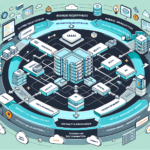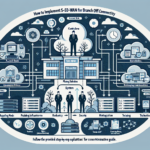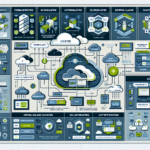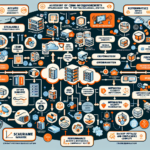Optimizing IT infrastructure for SaaS applications requires a strategic approach to ensure performance, scalability, security, and cost efficiency. Here’s how you can optimize your infrastructure to support SaaS applications effectively:
1. Adopt Cloud-Native Infrastructure
SaaS applications often benefit from cloud environments due to their scalability and reliability. Leverage public, private, or hybrid clouds depending on your business needs.
– Use Infrastructure-as-Code (IaC): Automate deployments with tools like Terraform or Ansible.
– Choose the Right Cloud Provider: Evaluate AWS, Azure, or Google Cloud based on services, pricing, and regional availability.
– Leverage Auto-Scaling: Enable dynamic scaling to handle fluctuating workloads.
2. Prioritize Performance with Virtualization
Virtualization allows you to maximize hardware utilization and isolate workloads efficiently.
– VM vs. Containers: Use virtual machines for legacy applications; adopt containers (e.g., Docker) for modern microservices-based SaaS apps.
– Hypervisor Optimization: Ensure VMware ESXi, Hyper-V, or KVM hypervisors are properly tuned for optimal resource allocation.
– Invest in High-Performance Storage: Use NVMe SSDs or all-flash arrays to reduce latency for IOPS-intensive applications.
3. Leverage Kubernetes for Orchestration
Kubernetes is a powerful orchestration tool for managing containerized applications.
– Deploy Microservices: Break SaaS applications into microservices to enable scalability and agility.
– Use Helm Charts: Simplify deployment and management of your SaaS application stack.
– Implement Horizontal Pod Autoscaling: Automatically scale up/down pods based on CPU/memory usage.
4. Optimize Storage Solutions
SaaS applications often require high-speed, reliable storage.
– Use Object Storage for Scalability: Solutions like Amazon S3 or Azure Blob Storage are ideal for storing application data.
– Deduplication & Compression: Reduce storage costs with deduplication and compression technologies in backup systems.
– Enable Backup & Disaster Recovery: Use tools like Veeam or Commvault to ensure data integrity and availability.
5. Enhance Backup & Data Protection
Backup and data protection are critical for SaaS applications due to customer data reliance.
– Implement Incremental Backups: Reduce resource consumption during backups.
– Use Immutable Backups: Prevent ransomware attacks with immutable snapshots.
– Enable Multi-Region Replication: Protect data against localized outages.
6. Optimize Networking
Networking plays a critical role in the performance of SaaS applications.
– Use SD-WAN: Improve application delivery across distributed environments.
– Optimize Load Balancers: Use intelligent load balancers like NGINX or HAProxy to distribute traffic efficiently.
– Deploy Content Delivery Networks (CDNs): Improve user experience by caching assets closer to users.
7. Leverage GPUs for AI and ML Workloads
If your SaaS application incorporates AI/ML functionality, GPU optimization is key.
– Choose High-Performance GPUs: NVIDIA A100 or similar GPUs for deep learning and inference workloads.
– Deploy GPU Clusters: Use Kubernetes GPU operators to manage GPU workloads effectively.
– Optimize Drivers and Frameworks: Ensure CUDA, TensorFlow, or PyTorch frameworks are up-to-date for peak performance.
8. Ensure Security and Compliance
SaaS applications often deal with sensitive customer data, requiring a strong security posture.
– Implement Zero Trust Security: Verify and authenticate every access attempt, regardless of origin.
– Use Encryption: Encrypt data at rest and in transit with AES-256 and TLS/SSL.
– Regular Audits: Conduct vulnerability assessments and patch management regularly.
– Compliance: Adhere to GDPR, HIPAA, SOC2, or other applicable regulations.
9. Monitor and Optimize Application Performance
Proactive monitoring ensures consistent performance.
– Use Application Performance Monitoring (APM): Tools like Dynatrace, New Relic, or Datadog can identify bottlenecks in real time.
– Enable Observability: Implement logging, metrics, and tracing using tools like Grafana, Prometheus, and Elasticsearch.
– Analyze Resource Utilization: Continuously monitor CPU, memory, and storage usage for optimization.
10. Plan for Scalability
SaaS applications must scale to accommodate growth seamlessly.
– Horizontal Scaling: Add more servers or containers to distribute load.
– Vertical Scaling: Upgrade existing servers with more resources when needed.
– Database Scaling: Implement database sharding or replication to handle growing data.
11. Cost Optimization
Optimizing costs ensures profitability without sacrificing performance.
– Use Reserved Instances: Commit to reserved cloud instances for predictable workloads to save costs.
– Rightsize Resources: Continuously analyze and adjust VM/container resource allocation.
– Monitor Cloud Spending: Use tools like AWS Cost Explorer or Azure Cost Management.
12. Streamline Collaboration
Ensure seamless communication between development, operations, and IT teams.
– Adopt DevOps Practices: Automate CI/CD pipelines using Jenkins, GitLab CI, or GitHub Actions.
– Implement Agile Workflows: Ensure rapid iteration and feature delivery.
Summary
By adopting cloud-native infrastructure, leveraging Kubernetes, optimizing storage and GPU resources, and focusing on security, scalability, and performance, you can ensure your IT infrastructure is optimized for SaaS applications. Regular monitoring, cost control, and collaboration between teams will ensure continued success.




